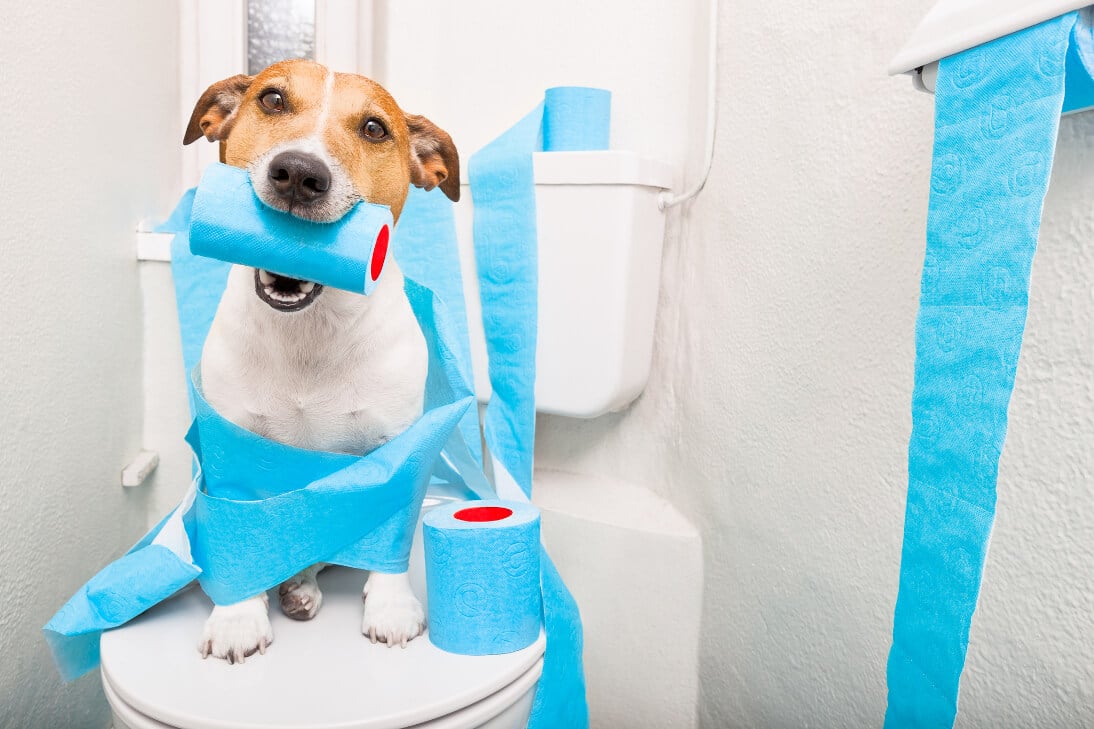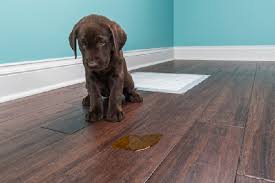
“I can’t seem to potty training my puppy. She doesn’t understand that she should pee and poop outside what should I do?” or “Uhhh, I thought when I get a new puppy that I will live a glamorous, beautiful life like the ones who appear on Youtube. Instead, I literally spend 24 hours clearing the messes in the house…” or “I really can’t live with all these messes, I have to return this dog. IT’S UNBEARABLE!”
Did you happen to hear those words from new owners a lot? That’s true because probably this is considered as one of the most FRUSTRATING issues any new owner faces. HOW CAN WE TRAIN PUPPIES TO PEE IN THE STREET!? And perhaps for me, this has been one of the easiest things ever, and unfortunately, when I tell people this, they are like “NO WAY.” So, in this article, I will walk with you step by step until your dog becomes a true master, forgetting all the lies that prevail the internet!
“Potty training is a mandatory subject that every owner should be familiar with. Whatever the breed or the age of the dog, you will have to potty train him. While the options are available to you, you are free to choose the best technique for your dog that guarantees comfortability for both of you. However, make sure that you set up everything and that you are ready to train your dog. Make sure that the crate is ready, and your schedule is well organized and grab the timer and start applying the techniques mentioned. Your dog will be fully potty trained in 2-3 weeks.”
My Story
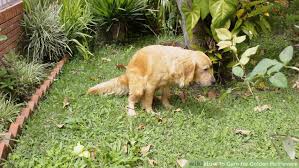
I am the owner of a Golden Retriever (Yes, she is the dog beside me in the picture), and she’s one and a half years now. I got it in June 2018, and as I read a lot of training books, I was ready to take this challenge. I didn’t listen to people saying, “Hey, you should wait until the dog is 3 and a half months to train him because he doesn’t understand before this age”. By the way, all of these things are lies. I started training my dog from the age of 7 weeks!
And guess what? She could pee in the street at the age of 9 weeks. Moreover, she barked when she wanted to pee while I am not around so that I can come quickly to take her outside and let her pee! Sounds sweet, right?
When I tell people this, they often tell me, “No dog can be fully trained at the age of 9 weeks.” This is true, as she had one mess per week. However, it’s better than 4 or 5 messes daily, right? Now, my dog never makes any mess in the house even if I left her for 14 hours. Can you believe that even when she wants to vomit, she sprints to the balcony door and opens it herself to vomit outside? She never wants to make any mess inside the house. That’s because she understands how important is the house and that she is not allowed to make it dirty!
So please, don’t listen to people telling you they managed to get their dog not to pee inside the house at the age of 8 or 9 months and that you can never do it earlier. It is easy to have a trained dog after one week of bringing him home!
And I will teach you a correct POSITIVE WAY to potty training your dog, which is free of any “PUNISHMENTS.” So, let’s continue together through this long journey.
How Does a Dogs’ Bladder Work?
We “HUMANS” have a limit, and we need to go to the toilet when we reach that limit. Whether that human is a baby, an adult, or a youth, they need to go to the toilet, and there is no way a human can hold it up to 24 hours! It is just impossible.
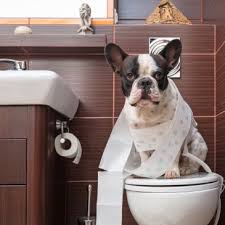
And believe it or not, dogs have the same thing. They have to go to the toilet, they have the same system we do, WHAT?
Yes, dogs have the same urinary system of the human. The kidney is sending the urine through arteries to the bladder that becomes full, and then he has to pee… I see a lot of people trying to push their dogs to hold it for 11 or 12 hours while their pup is still 5 or 6 months old. We should know the number of hours of holding the urine for any dog before starting potty training.
The calculation is simple, you take the dog’s age in months, converting it to hours and adding one hour to it, got it? Let me give you an example, let’s say you have a 2-month-old dog. That means your dog can hold his urine for up to 2 + 1 = 3 hours. I just converted his age to hours and added one hour to it. However, an adult dog can reach up to 12 hours only! Never make it longer than 12 hours, as this is way too dangerous.
That means a dog who is 6 months old can hold his urine for 7 hours, NOT 12 or 14 HOURS! And later, I will tell you how you can damage your dog’s bladder if you pushed him that far that you can even kill him.
Potty Training Your Puppy
And now, let’s start working. Before I jump into potty training a dog, let me address some facts so that you can keep your dog healthy.
When Can a Dog Go Outside?
So for medical reasons, you can never let your dog start going to the street before hitting 3 or 3 and a half months. Before that age, he will not have a well-developed immunity system, and he will be prone to hazardous diseases like Pravo. And by the way, this is a mistake I have made with my dog. I had to treat her for Parvo because I didn’t listen to any advice.
Please don’t ignore that (as I did), especially if you have Pitbull or Rottweiler as they are much more likely to get such diseases.
So you have two options now:

- Potty Training your dog at home until he reaches 3.5 months, and then you are ready to go outside.
- Buy a 3.5-month-old dog (not 8 weeks old)
So you are free to decide, and I will cover the first option in a second. Now, let’s assume your dog has already reached 3.5 months old, you are ready to potty train him now. Let’s start this training process.
General Methodology of Potty Training Any Dog
Whatever you choose, whether you want your dog to pee in the house or outside on the street. There is a simple methodology that we have to follow, and that will let you understand everything about potty training.
When you get your dog, he doesn’t understand what you are asking from him at all. He is still new to this world besides that the real dogs don’t care about the place of their peeing, so we have to introduce this new idea for the dog. So how can we do that?
We can do that gradually, the most important thing is to remain consistent. However, let me answer a question first, how do dogs know the place of their peeing?
Same texture only
Generally, dogs know where to pee (after training) by two methods.

- First – the texture feeling of the medium they stand on, and that’s because their paws are made of skin.
- Second – the smell of their markings.
Why did I say all of that?
To introduce you to this, “Try to stay consistent as much as possible with the texture.” Most of the owners I see will make the dog pee on the grass one day and will push him to pee on the sand the next. And the dog doesn’t understand that’s because there is no consistency.
Remember, dogs can’t know at the beginning that both are acceptable, they are trying to follow the instructions.
- Rule 1 – try to make the medium of peeing as consistent as possible and never change it unless you were forced to.
- Rule 2 – is knowing how long you should leave your dog without peeing at first.
As I explained to you above that the maximum hours that a dog can hold his pee is equal to his age in months with the addition of one hour. However, as you read, that’s the MAXIMUM. You can’t start by leaving the dog for 2 or 3 hours without peeing, he still doesn’t understand.
So, you should introduce him to the new concept of controlling his bladder step by step using the following table:
| Time | Dog’s waiting without peeing |
| 1- First 3 days | 20 mins. |
| 2- The 4th day | 25 mins. |
| 3- The 5th day | 30 mins, |

And you can continue yourself until you reach the maximum amount which increases month;y by one hour. So, imagine your dog on the 5th day couldn’t hold it for 30 mins, what should you do?
Nothing, just go one step back and make him wait 25 mins only then take him to pee and repeat this for 2 consecutive days.
There are other things to put into consideration where dogs will have to pee after:
| 1- After Eating | You have to let your dog out to pee after 10-15 mins of his meal (he will usually make stool too). |
| 2- After Playing | Like humans, dogs will pee after doing any exercises. |
| 3- After drinking excessively | When you hear him drinking excessively, wait 5 mins and carry him out to pee. |
So use both tables to schedule the time of your dog’s peeing.
Teaching Your Dog The Place
Now, you might be wondering, will the dog “WAIT” the first day or two? No, he won’t, and he will make messes. So, how will he learn to “WAIT”? By treats. Only by treats and by crating. Dogs are cute creatures, and they adore praising.
The Idea of Crating
Ok, so a general fact. Dogs don’t love to pee where they sleep (unless they had to). Every other place in the house is fine, but the place where he sleeps will be the cleanest. So, how can we use this? Yes, to crate him or to set up baby doors for him.
So if you put them in the crate for the 20 min-wait, they will never pee inside it and will wait for you to let them go to pee. However, if you forgot, he will start peeing in the crate. And after he did that several times, he will start developing that as behavior, and it will become his nature.
You can prevent it by setting a timer so that when the waiting period passes, you immediately pick him up and run to the street or the peeing place. Also, some people will leave peeing pads in the crate. I can not recommend you do this. Leave him in the box without peeing pads, so he will have to wait for you to get him out to pee. This video for Zak George demonstrates how to crate train your puppy.
Wondering where to buy the best crates?
Sure, chewy offers a massive range of products. I have chosen a variable crate, It’s size can be changed depending on the size of the dog.
How big should a dog crate be?
Generally, you can’t have a too-large crate for the dog, because this will give him much space. Too much space gives him room to pee on one side and sleep on the other.
The crate shouldn’t be tiny, either. Your dog needs a little space to move.
That’s why I love the variable box for dogs as you can experiment with it until you find the best one that works for your dog like a charm! You can see it here! You can also carry it anywhere as it is foldable too 😉
The Training
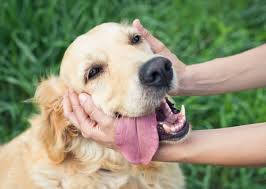
Use love, praises, and treats. In the first 2 days, try to let him as close as possible to the place of peeing (assuming they are peeing inside the house). Try to go out with them frequently (assuming you are training him to pee on the street). Wait until he pees in the correct place and give him a treat immediately!
Once you do this 3 times, the dog will try to do it in this place as much as he could, and thus will try to wait until he reaches this place. That’s when you can use the crate to force him to wait and use the waiting periods that I mentioned in the above tables.
Usually, it will take the dog a day or two to understand that this “PLACE” gives him treats.
How will the dog distinguish the peeing site from the regular? It’s pretty simple, the peeing place has treats followed by a playing session, and the regular place doesn’t have.
So once your dog starts to hold it for 20 mins, I can tell you congratulations, your dog is potty trained, what?
Yes. The dog understands where he should pee, however, the rest is on YOU only now. You are the one who should put a timer for your dog and let him go to pee on time, and then praise him.
To summarize potty training a dog:
you will have a fixed medium (indoors or outdoors), whether grass, paper, or sand. When your dog arrives, you will try to let him access this place as much as he could, until he pees there “ACCIDENTALLY.” Then you immediately praise him and make him look like a hero! Then you start scheduling the peeing, teaching him how to control his bladder by using a crate and praising. Pretty simple, isn’t it? Now let’s address the “FRUSTRATING” Scenarios.
Frustrating Scenarios
While the above method will work 100% great, there are scenarios where you will find it very very frustrating. Let me go through them:
Getting up in the middle of the night or the early morning

To achieve the best results, you have to wake up in the middle of the night and move your dog to his peeing place (whether it is in the street or inside the house) to make him pee. Otherwise, you will find messes in the morning. I had to wake up at 2 and 4 A.M. to let my dog pee in the street (and it was freezing).
I know it’s frustrating. However, doing it once will be far better than having to clean your house every half an hour. There is a solution (when the dog reaches 3 months).
Your dog gets excited and forgets to pee

Unfortunately, it happens a lot, especially in the street where there are lots of exciting distractions for them! I can’t remember how many times it happened to me, my dog was about to pee, she just saw a cat, and here we go.
Usually, when something like this happens, the only solution is to redirect them by moving away. Try to choose another place where things are quieter, for example, so that you won’t have the same issue.
Your dog refuses to pee
Uhhh, Kira, I think we might be addressing you here…

Unfortunately, you will face this issue a lot! Where your dog just wants to play, and never wants to pee and this has no solution. You will have to wait beside him patiently even for an hour until he finally decides to let go of his bladder.
I can still remember Kira doing the same cruel things to me when she was young (dogs aren’t that cute, haha)
How to Deal With Dog Mess?
Ok, so if you followed the above guide carefully, you would have a very disciplined dog from the 2nd week (just as I had). This doesn’t mean that there won’t be any mess once every 2 or 3 days, because sometimes you forget the dog, or he has done several exercises, and you didn’t take him to pee.
So, messes are present, I never said that this guide will make your dog 100% trained from the first week, he has to do messing. However, I consider dealing with those messes an art, where you can teach your dog the right thing without punishing.
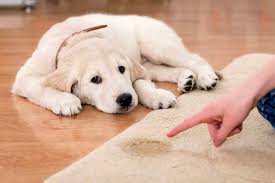
First, never punish a dog. No matter how many times you see on blogs saying that you can put your dog’s nose in pee, then yell at him. All of this is useless and does nothing except hurting your dog. I will say how in a minute. So please, no punishments (more on this topic in the next headline).
So, when you find out that your dog has made a mess, you will see how smiling he is as if he has done something beautiful. Anyway, what you have to do is to carry him to his place of peeing because usually, he wouldn’t have emptied his bladder and would need to pee more. So that’s the first thing I did, I carried my dog to the street and waited. Then I gave her a treat, no matter how angry I am. I have to be consistent with praising (that will make her love the street). Then I go upstairs, leave her away from the mess, and clean the place. Never clean the spot in front of your dog as he might think that this is sort of a game where he pees and you clean. Don’t yell or punish your dog or put him in his crate. Just clean the place quietly.
If I caught my dog peeing in front of my eye, I try to distract him by clapping or saying no (not angrily), so she will turn immediately and stop. Then I carry her to the street and repeat the praising step. If you caught your dog peeing in front of you, you might be lucky as this will make him understand that the street or the potty pad is better than the house.
You can use some Odor remover to remove the smell of peeing from the floor so that he won’t do it again in the same place, you can find this amazing one here which has a discount now on chewy.com. Then you are happy to return to play with your dog. However, don’t play with him or give him a treat in front of the place of the mess (so that he won’t connect that: making a mistake will give him treats).
The Results of Punishments and Pushing

Potty training should be founded on love and understanding between you and your dog. How you want your dog to behave and how the dog wants to make you happy and does something weird to his instinct to make you pleased.
Imagine you are forced to eat with your leg, and while you are still learning, you made a mistake, someone came to you and struck you. Or worse, put your nose in the food you have dropped. You will find it very unfair, right?
Same for dogs guys, he is not used to what you are asking of him. So be patient and give him the support and love he needs to make the best of it. So, what will happen when you decide to punish your dog by hitting/yelling/rubbing his nose in his pee/timing him out/etc.?
We can classify the result of dog punishment (or negative reinforcement) in two:
Physical Damages
People have success with all kinds of training methods because they build habits. No matter how abusively you treat a dog, if you keep taking them outside, they’ll sooner or later get potty trained.
Little Dog Tips
Do you know what rubbing your dog’s nose in his pee can do?
All the reports have shown that some dogs lose their smelling instinct through this unbelievable experience. Even if your dog doesn’t show a sign of any issue, I am sorry to say that the dog’s sensitive nose can get damaged because of you.
Do you think this is the only issue? Unfortunately, no.
The punishing method can work. You make your dog hold his pee until you allow him to go out. He can even hold it longer than you expected, and you started to feel happy as it worked.
Then months later, you noticed that your dog is peeing excessively, why is he doing that? Isn’t he trained? You go to the vet, and he tells you your dog has Urinary Tract Infection or Bladder Infection or Kidney Infection, why? Yes, because he held it longer than the maximum amount of hours.
Some people still don’t believe how serious it is. Let me tell you a quick overview of what are those diseases in the following table:
| Disease Name | Symptoms | Causes | Treatment |
| Urinary Tract Infection | Frequent urination, Breaking housetraining. Blood in the urine. Dribbling urine Crying out while urinating, straining to urinate, Frequently or obsessively licking the genital area | HOLDING HIS PEE LONGER THAN THE USUAL, Incontinence from excessive water drinking, Stress, Cancer, Trauma, Congenital abnormality, diabetes, etc. | Treatment of such a disease comes in many forms such as Antibiotics, Surgery, treatment of the underlying condition, remove the stone from the bladder if any were found, etc. |
| Kidney Infection | Same as above | Urinary Tract Infection | Depending on the issue. |
Does this sound confusing? The urinary tract infection causes the precipitation of bacteria in the bladder of the dog. This bacteria may invade the kidneys and cause their failure. I am sorry to tell you this. Most of the time, this disease has no real treatment, the dog may take some antibiotics to live longer, however, just like a human, he will suffer a lot and may die at the end. So, please think wisely about the health of your dog. You never want your dog to suffer because of you, right?
Behavioral Damages
You punished your dog for peeing in the house, and your dog didn’t pee again, how awesome!

Then you suddenly found that the dog is peeing under the bed. That’s because he understood that peeing in front of you will be the source of punishment, however, peeing without you taking any notice won’t cause any punishment.
Another behavioral issue (that happened with my dog, unfortunately) is the dog trying to lick his pee or eat his poo to please you. WHICH DAMAGES HIS ORGANS. However, in my case, Kira does this because she doesn’t want to upset me (even if I had never tried to punish her), but she loves me too much that she feels guilty a lot.
Potty Training your dog in the street:
Now, I will cover the particular points related to potty training in the street or the house. We will follow the same methodology, which is waiting, gradually increasing the time and praising. Let’s start by addressing the Potty Training in the street.
This is my favorite type, a lot of people decide to go with option B, which is potty training the dog to do inside the house. Well, depending on the situation, both are acceptable as some people don’t like walking or aren’t able to walk. I prefer to let my dog pee in the street. This doesn’t need cleaning (only lifting the stool) in the house. Also, the dogs need to walk every day, so this will be considered her daily walks.
Equipment needed.
Generally, this type needs no special equipment, just a plastic bag to carry the poop of your dog. Please, don’t ignore this; after all, not everyone wants to step onto dog’s poop on his way to work. You can buy fantastic 120 Poop Bags that are not harmful to the environment. You can check them out here.
Training:
Nothing fancy, you just walk randomly until he pees. Try to stay out of distractions as much as possible. Usually, you will see that there is a special sign he/she does before peeing. For example, he will suddenly walk slower, and then start peeing immediately after that.
So, when you notice this, try to say a keyword like “Pee” just before he starts peeing. This will teach him that the word pee means that he should go out to pee and then praise him after that like a Hero. However, don’t sound very energetic when you tell him to pee as he might consider it a sign to play instead of peeing. When you praise him, do try to sound as energetic as possible.
Pros:
- No matter how much poop you lift, it is still better than cleaning the house.
- You can combine peeing with the daily walks he gets.
- This forces you to walk the dog daily: Because some people (if their dog is trained to pee indoors) forget to walk their dog. This will cause the dog to develop behavioral issues.
- It gives your dog the opportunity to socialize at an early stage: Because he will go out a lot so he will see new people and animals every time he goes out.
- Will sniff his way to pee, which will make him know the world so early.
Cons:
While the pros of this stage are a lot, the disadvantages are, unfortunately, a lot too.
- Can hurt the dog: If you are living on the 4th floor and your dog has to get down using the stairs every 40-50 mins, then he is prone to hip dysplasia. I prefer to use the second option for this. So, what you can do is start potty training him indoors until he hits 6-7 months where he can hold it up to 7 hours, then you can start introducing peeing in the street only.
- Not suitable for everyone. If someone has walking issues or can’t stand for a long time, then this won’t be an effective solution for him.
- Not suitable if you bought your dog in winter: You don’t want to damage the dog for peeing, right? Dogs can’t handle that freezing weather at 2 months.
- Not suitable if there are lots of squirrels, cats or stray dogs.
- It can make you wait much longer for him to pee because there are lots of distractions.
If you find yourself suffering from one or more of the above issues, then perhaps you can use Option B:
Potty Training Your Dog Indoors
While I don’t like this option, however, sometimes I find it the best for many persons who can’t walk a lot. However, this will cost you some money to set up a good environment for your dog. This will need extra effort because you are trying to tell your dog, no place in the house is allowed except this place. However, there are lots of equipment that can make this process eassier for you.
So, let’s see the equipment you might use:
Equipment Needed
Here you have to have some equipment. The crate training I mentioned earlier is mandatory. However, you can use some equipment that will lure the dog to pee on them. Also, using the same methodology we mentioned above. So here is a list of equipment that you can use in addition to the crate:
- Potty Pad: The idea of a potty pad is that it has a scent that attracts the dog and so he will pee on it. While this is a dream for owners to easy the Potty Training process of their pups, however, many scientists explained that this can lead to an incomplete potty trained puppy. So you can use it at the beginning of potty training however you will have to change it sooner or later. Anyway, you can find an amazing one here. And cleaning them is super easy. Just replace the sheet. However, you can never leave it with the dog inside his crate as I mentioned, this will teach the dog to pee inside the crate and sooner or later, he will play with it (I hate them). The problem with the pads is that dogs get used to peeing according to that smell. So later, when the pads aren’t available, your dog will be confused and will pee inside the house.
- Potty Grass: Instead of the pads, you can buy the grass mat. While this doesn’t offer any scents to attract your dog, it might be considered an excellent option. Because it teaches your dog to pee on the grass, and later, he can pee on the grass outside. It also doesn’t need replacement, just let it dry in front of the sun. I do recommend them, they will make it very easy for the dog to move from peeing indoors to peeing on the street.
The Training
Same methodology of crating, waiting, and praising. However, most of the time, indoor potty training is considered a transition period, where when the dog becomes fully grown, you can take him outdoors. Because you can’t keep pads all your life and also as I mentioned when you travel with your dog and there are no pads or grass mats, you will struggle a lot. So consider it as a transition period that will end once your dog reaches 7 or 8 months. You will then start to introduce him to do in the street instead. I also want to mention that you will struggle at the beginning. In a dog’s mind, it’s easier to do it indoors instead of waiting to go outside.
We can summarize the pros and cons as the following:
| Pros | Cons |
| A very option if you can’t go out a lot. | Very bad option over the long term. |
| A very good option in the beginning, but not effective over the long term. | Will lead to many struggles if you intend to move your dog to pee outside after some time. |
| The best option for puppies who haven’t completed their shots. | Require constant cleaning. |
I have covered all the options and how to train your dog well, no matter which option you choose.
How to Know If You Are Succeeding?
Whew, so much time has passed, and you have set up everything according to your needs. The crate is ready, the timer, and everything else. You followed every step, but you don’t know whether you are improving or not. Some times you can feel as if your not making progress while you are doing a lot. Let me share this quick story with you:
I have a friend whose dog always kept barking during the night. It made my friend extremely furious. She kept calling me, telling me. This especially is no “strange thing.” Until she decided to punish him and yell at him. From that moment, she had to clean the house every day in the morning because he makes messes. She was telling me that her dog was completed potty trained and that he never makes any messes in the house.
She is furious that he still does that during the night. After she yelled at him, he started to make even more mistakes. I told her that’s because the dog was trying to call you to let him PEE. He didn’t want to make any noise, he just wanted to pee, and you didn’t interpret that right. When you yelled at him, he stopped barking, but he peed even more because he can’t go on his own.
That’s a true story that I see happen every day. You have to see the small changes happening and respond to them. If your dog looks at you before peeing, this is considered a new step. You have to look at every situation from other perspectives.
A general rule thumb, you can consider yourself succeeding if you find that the number of mistakes is decreasing gradually. Today, your pal made 5 mistakes, that’s an improvement from the 8 mistakes he did 3 days ago! Changes won’t happen overnight, you can get your dog fully potty trained in a week. He can still make mistakes until he completely grasps the idea of potty training.
Look for small changes and consider them as ways of succeeding. If the number of peeing decreases that would be great, if he barked before peeing, that would be a success, if he kept whining for you to get him outside, that’s a lot of success! Always look at the brighter side.
After Basic Potty Training
Usually, when the dog understands potty training, he will start whining when he wants to pee as a sign for you. However, after you finish basic potty training, there are a lot of options for you to follow, and that will make the potty thing easier. Some of them are:
Teaching Your Dog to Bark When He Wants to Pee.
I did this to my dog, and it eased the process a lot. The general idea is to teach him how to bark at first which you can find Zak George giving a fantastic episode about this subject:
After your dog understands the Bark command, just use it before you move him to his pee place, and don’t forget to praise him. Repeat it every time, and then when you forget your dog, he will tell you when he needs to go (don’t depend on this too, try to remember him).
Teaching a Dog to Use a Doorbell For Peeing
This may be my favorite trick of all, as it is much quieter than the bark one. However, if you don’t have a crate for your dog like me, you won’t be able to use this trick a lot. I couldn’t use it as I couldn’t find a place for the bell ring. Generally, you teach your dog to ring the bell when he wants to pee so that you can come and let him go. It’s a fantastic trick that will increase the intelligence of your dog too! You can find amazing doorbells for dogs for about 5$ here. They are beautiful.
Zak George also offers an amazing video about training your dog how to use for potty training here:
Teaching Your Dog to Use Pet Doors
Oops, you are are having 9-5 working hours, and you can’t let the dog pee on time, or you want to decrease the struggle of your dog, which wants you to open the door for him every time he wants to pee? Perhaps it is best to teach him how to use pet doors to go outside to pee.
ATTENTION

While this technique is beautiful, do it only when you have a fenced backyard. Only if you are sure that the dog can’t jump over the fence and simply run away. I have seen so many people losing their dogs because of this door. This door isn’t intended to be used by the dog to go outside whenever he wants to “RUNAWAY” but instead to pee and maybe wander around the garden a bit then return to you. Please, take care of your dog.
This is an amazing technique. The dog will use this door immediately when he wants to go out without the need for training (only if he knows that he has to pee outside instead of peeing inside). You can get this fantastic door from chewy too! If you wanted to teach your dog how to use it in case he couldn’t understand it himself, you can look at this article here which covers in detail how to teach your dog to use such a door for potty training.
Congratulations, your puppy just went from zero to hero with amazing tricks, and he became a master potty trained dog. There are some special problems that you might find during the training process (I did myself), and I wanted to address them so that we would have covered everything.
My Dog Makes Mistakes, No Matter How Well He Is Trained
While the above statement may occur due to a lack of proper training and communication with the dog. However, unfortunately, some times your dog will make mistakes even if he knows that this is a mistake and that’s because there is something wrong that is not related to training at all and it comes down to two issues:
Medical Issues
Sometimes the dog will pee inside the house even if he is trained because he has a medical problem that causes this behavior. Fortunately, some of these diseases can be cured, and some can’t. I have covered them above. There are many more diseases. However, they are not common, and the list will be too long. You probably won’t bother yourself with all these diseases, so I covered the most important ones only.
Behavioral Issues Affecting Potty Training
I always say this phase tests you as an owner. 60% of the time, you will notice your dog has weird behaviors when he hits 8 months old, as this is his teenage period (just like humans). He will have some problems and some behaviors that will frustrate you like peeing inside the house. And it is not because he is not well trained but because he is passing a hard time and you should help him. Why do I say that this tests you as a real professional owner? Because most of the time, these behavioral issues have to be addressed by you solely, and you won’t find a lot of information about these behaviors on the internet.
Some of these behavioral issues can be found on the internet, and many others are unique issues related to your dog. Before we talk about them, I want to share my own story with Kira so that you can understand what I am talking about, and see how I managed her problem myself.
So, my dog loves me and adores playing with me, everyone who sees her says she is highly trained to pee outdoors. However, she had a strange problem at 8 months old. When she was angry, she could drink excessively and pee in front of me. That was very weird and frustrating for me. The problem got bigger and associated with the Separation Anxiety that she had. She started to pee whenever I leave her in her room alone and won’t like her to come outside because I was doing something. So now, whenever she finds herself alone, she will drink and pee.
While many people will say that is because of Separation Anxiety only, it isn’t. It is something far beyond that, she pees to say that she is angry. I kept searching for anything similar and asked trainers, everyone said that this might be Separation Anxiety, but every method failed. Because it wasn’t Separation Anxiety as people assumed. So, I started addressing the issue (by experimenting).
First, I made her go out to pee, and I played with her, so her energy is drained. Then, we went up, I removed the water (for 20 mins only) so that she won’t have access to any source where she can pee using this source. I went out of the room, locked it as usual, and turned on the frier (as if I am cooking), then I returned after 20 mins and voila! No Pee! I gave her lots of chicken, we played together, and she was very happy. I repeated this daily for 3 weeks. After that, I started to leave the water when I went up, and she didn’t pee. She understood that her way of relieving the stress by peeing was a bad thing. She found that waiting for me patiently will result in lots of praise instead!
See, I tried to figure out something for her that is not on the internet. Some issues are unique to dogs, and you have to be creative when finding a solution to the problem your dog is facing yourself. However, as I mentioned there are common behavioral issues you might look at when your dog is peeing inside the house, and he is fully familiar with Potty Training (however, you should run all the checks first to make sure that your dog isn’t suffering from any disease) which are:
- Marking: This happens in males because they want to marry. It often happens too when there is a new dog in the area or a female dog. This may be solved after being altered.
- Submissive Urination: Unfortunately, this is pretty common in dogs too. Peeing because he is afraid, usually, this resolves by itself over time. You can read more about it here.
- Excitement Urination: Sometimes, the dog will pee when he sees you because he is excited! While this is lovely, it is kinda frustrating. You can see how to deal with such a thing here.
- Peeing due to Separation Anxiety: That will resolve when you deal with the separation anxiety of the dog and make it disappear. You can see how to deal with separation anxiety in dogs here.
- Habit: Unfortunately, sometimes people just don’t care about training their dogs, and he just develops the habit of peeing inside the house. When a dog is having this issue, it’s best to change this habit by using the same methodology we covered above. Even if he is an adult dog treat him like a puppy.
Writing the solution to every problem is hard to cover in this article. Every issue needs a separate article to address independently. That’s why I preferred to write the headlines with the short paragraphs and the link to the articles.
Dog Training Books
While this article went through everything you would face during the Potty Training process. Some people prefer to have Dog Training Books so that they can be a reference with them, I would recommend the following books for any owner, also wait for an article where we cover the top 10 Training Books for every field in Dog Training, however for now, I have covered the most important ones which are:
- Zak George’s Dog Training Revolution: The Complete Guide to Raising the Perfect Pet with Love: Which comes available in all versions including Paperback, Audio version (free), and kindle.
- The Art of Raising a Puppy: Oh baby, this one is beautiful, the same as above available in all versions with a free audio version.
- The Dog Encyclopedia: The Definitive Visual Guide: Well, I would advise you to stay away from this book if you are new to dog training world as this is extremely hard to follow however a beautiful one (If you read it, you will become a master)
- Think Like Your Dog and Enjoy the Rewards: A fascinating book that is rewarding, I enjoyed its way of writing!
These books have given me a lot of information. I would have never gained the information without them, and I want to thank every writer for taking such an effort to write these beautiful books.
Conclusion
Potty Training is a mandatory subject that every owner should be familiar with. Whatever the breed or the age of the dog, you will have to potty train him. While the options are available to you, you are free to choose the best technique for your dog that guarantees comfortability for both of you. Make sure that you set up everything and that you are ready to train your dog.
Whew, was a long article, wasn’t it? It had taken a lot of effort to write this article, and I am sure it had taken a long time to read it too. We wanted to give a full professional training guide that will make your dog a hero. We would like to thank our loyal reader Mombay for suggesting this topic to us, and I hope that he likes this article.
Have you read our post on how to clip dog’s nails?
The K9backpack’s team is now offering a huge service for you guys. You can tell us, in the comment, a problem that your dog is going through. We will work with you until you figure it out based on your circumstances. Whether it was chewing, separation anxiety, or any behavioral problem and for free! I hope to see lots of comments.

